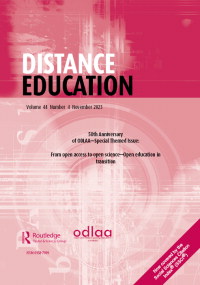新冠肺炎期间的异步和同步远程教学和学术成果
IF 3.7
1区 教育学
Q1 EDUCATION & EDUCATIONAL RESEARCH
引用次数: 6
摘要
新冠肺炎疫情促使高等教育普遍转向远程教学,给教育工作者和学生都带来了挑战。本研究调查了在澳大利亚全国范围内的COVID-19封锁期间,学生参与不同类型的远程教学(异步和同步)与学术成果(平均成绩和学术满意度)之间的联系。与大学的联系是作为这些联系的调节者进行测试的。结果发现,与大学联系程度高的学生,更多地参与同步教学,平均成绩和学业满意度更高。相反,对于那些与大学联系较低的人来说,更多地参与异步教学与更高的学业表现满意度有关。这些研究结果表明,同步和异步远程教学模式对学生的学术成果都很重要,并且在远程教学背景下,大学连通性在促进积极的学术体验和成就方面发挥着关键作用。本文章由计算机程序翻译,如有差异,请以英文原文为准。
Asynchronous and synchronous remote teaching and academic outcomes during COVID-19
Abstract The COVID-19 pandemic has prompted widespread transitions to remote teaching and learning in the higher education sector, bringing challenges for both educators and students. This study investigated links between student engagement with distinct types of remote teaching (asynchronous and synchronous) and academic outcomes (grade point average and academic satisfaction) during the nationwide COVID-19 lockdown in Australia. Connectedness to the university was tested as a moderator of these associations. Results found that students with high levels of university connectedness that engaged more with synchronous teaching had higher grade point averages and academic satisfaction. Conversely, greater engagement with asynchronous teaching was associated with increased satisfaction with academic performance for those low in university connectedness. These findings suggest that both synchronous and asynchronous modes of remote teaching are important for students’ academic outcomes and that university connectedness plays a critical role in promoting positive academic experiences and achievement in the context of remote teaching.
求助全文
通过发布文献求助,成功后即可免费获取论文全文。
去求助
来源期刊

Distance Education
EDUCATION & EDUCATIONAL RESEARCH-
CiteScore
10.70
自引率
6.80%
发文量
29
期刊介绍:
Distance Education, a peer-reviewed journal affiliated with the Open and Distance Learning Association of Australia, Inc., is dedicated to publishing research and scholarly content in the realm of open, distance, and flexible education. Focusing on the freedom of learners from constraints in time, pace, and place of study, the journal has been a pioneering source in these educational domains. It continues to contribute original and scholarly work, playing a crucial role in advancing knowledge and practice in open and distance learning.
 求助内容:
求助内容: 应助结果提醒方式:
应助结果提醒方式:


